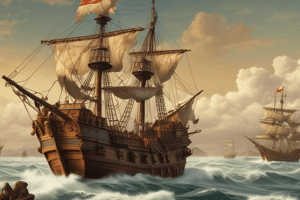Podcast
Questions and Answers
What significant action did Charles take regarding taxation during his rule?
What significant action did Charles take regarding taxation during his rule?
- Increased taxation on the colonies
- Introduced a new tax on agriculture
- Suspended supplementary tax (correct)
- Eliminated all taxes on trade
What significant event occurred in 1554 during Charles's reign?
What significant event occurred in 1554 during Charles's reign?
- Charles abdicated the throne
- Charles married his son Philip II to Mary Tudor (correct)
- The Council of Indies was established
- Rebellion was completely suppressed
Which council was part of Philip II's centralized bureaucracy?
Which council was part of Philip II's centralized bureaucracy?
- Council of Colonization
- Council of Trade
- Council of Agriculture
- Council of State (correct)
What factor contributed to the population growth in England and Wales by the 1590s?
What factor contributed to the population growth in England and Wales by the 1590s?
What was a primary export of the Spanish economy during this period?
What was a primary export of the Spanish economy during this period?
What was the primary natural resource mined in Potosi that significantly contributed to the Spanish economy?
What was the primary natural resource mined in Potosi that significantly contributed to the Spanish economy?
Which region of Spain was recognized for its agricultural production of wheat, olives, and wine?
Which region of Spain was recognized for its agricultural production of wheat, olives, and wine?
How did the Spanish nobles' attitude towards trade change over time?
How did the Spanish nobles' attitude towards trade change over time?
Which council was specifically responsible for overseeing colonial administration in the Spanish Empire?
Which council was specifically responsible for overseeing colonial administration in the Spanish Empire?
What was a significant demographic trend in England and Wales during the 1500s?
What was a significant demographic trend in England and Wales during the 1500s?
What was a major reason for the economic focus on an export economy in Spain?
What was a major reason for the economic focus on an export economy in Spain?
Which materials were brought into Spain from other regions to support their economy?
Which materials were brought into Spain from other regions to support their economy?
What was one of the outcomes of Charles's decision to suspend supplementary taxes?
What was one of the outcomes of Charles's decision to suspend supplementary taxes?
Flashcards
Philip II's Centralized Bureaucracy
Philip II's Centralized Bureaucracy
Philip II centralized the Spanish government with councils like the Council of State for policy, the Council of War for military matters, and the Council of Indies to manage colonial affairs.
English Population Growth
English Population Growth
The population of England and Wales rose significantly due to factors like improved farming, earlier marriages, and fewer plagues, leading to a boom in population.
Spanish Export Economy
Spanish Export Economy
The Spanish economy relied heavily on exports, particularly precious metals like silver, lead, and iron, as well as wool. It also imported goods like wine, oil, European grain, and clothing.
Council of Indies
Council of Indies
Signup and view all the flashcards
Polonia
Polonia
Signup and view all the flashcards
Spanish Crown's Income from Colonies
Spanish Crown's Income from Colonies
Signup and view all the flashcards
Potosi Silver Mines
Potosi Silver Mines
Signup and view all the flashcards
Spanish Nobles & Trade
Spanish Nobles & Trade
Signup and view all the flashcards
Silver Mining and Slavery
Silver Mining and Slavery
Signup and view all the flashcards
Spanish Colonial Administration
Spanish Colonial Administration
Signup and view all the flashcards
Spanish Centralization of Power
Spanish Centralization of Power
Signup and view all the flashcards
Spanish Economy: Exports and Imports
Spanish Economy: Exports and Imports
Signup and view all the flashcards
Study Notes
The Spanish Economy
- Spanish colonies generated approximately 10% of royal income.
- Mexican gold and Potosi silver mines were crucial sources of wealth.
- Silver refining tripled the silver yield.
- Mules transported silver from Potosi to ports (12,000 ft elevation)
- The sea voyage took months.
- Proceeds from silver financed African slave trade.
- Northern Spain (Catalonia) had farmers and fishermen.
- Southern Spain (Andalusia and Granada) produced wheat, olives, and wine.
- Terraced hillsides were used for vineyards and olive groves.
- Spanish nobles were involved in trade before the 18th century
- Export of Spanish goods to colonies was significant.
- Royal revenue came from taxes on commerce and manufacturing.
- Taxes were imposed on imported goods and exports.
- Movement of sheep through mountain passes required payments.
- Imports of foreign goods were restricted(tariffs).
- Colonization led to development of cities by shipping colonial goods.
- Challenges existed, including revolts like the Comuneros revolt in 1520.
- There were royal councils and councils of state.
- Local rule was practiced in the colonies by collaboration with native rulers/leaders.
Demographic and Economic Expansion
- 16th century Spanish population growth was notable.
- England and Wales populations grew from 2.5 million to 4.5 million.
- Improved farming practices and new crop introductions.
- Increased marriage rates and childbirth influenced growth.
- Epidemics and disease decreased in frequency.
- Migration from rural areas to cities occurred.
- London's population increased significantly, reaching 375,000 in 1650.
Studying That Suits You
Use AI to generate personalized quizzes and flashcards to suit your learning preferences.




